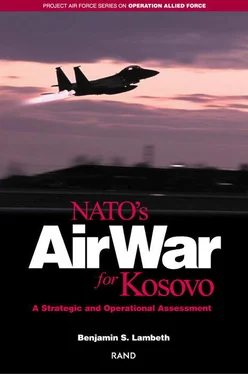Yet notwithstanding its ultimate success, what began as a hopeful gambit for producing Milosevic’s quick compliance soon devolved, for a time at least, into a seemingly ineffectual bombing experiment with no clear end in sight. Not only was the operation’s execution hampered by uncooperative weather and a surprisingly resilient opponent, it was further afflicted by persistent hesitancy on the part of U.S. and NATO political leaders and sharp differences of opinion within the most senior U.S. military command element over the most effective way of applying allied air power against Serb assets. Moreover, the plan ultimately adopted ruled out any backstopping by allied ground troops because of concerns over the potential for a land invasion to generate unacceptable casualties and the consequent low likelihood of mustering the needed congressional and allied support for such an option. All planning further assumed that NATO’s most crucial vulnerable area was its continued cohesion. Therefore, any target or attack tactic deemed even remotely likely to undermine that cohesion, such as the loss of friendly aircrews, excessive collateral damage, or anything else that might weaken domestic support, was to be most carefully considered, if not avoided altogether. All of that, however unavoidable some aspects of it may have been, made NATO’s air war for Kosovo a step backward in efficiency when compared to the Desert Storm air campaign.
WHY MILOSEVIC GAVE UP WHEN HE DID
We may never know for sure what mix of pressures and inducements ultimately led Milosevic to admit defeat. Yet why he gave in and why he did so when he did are by far the most important questions about the operation’s experience, since the answers, insofar as they are knowable, may help illuminate the coercive dynamic that ultimately swung the air war’s outcome.
One can, of course, insist that air power alone was the cause of Milosevic’s capitulation in the tautological sense that Allied Force was an air-only operation and that in its absence, there would have been no reason for believing that he would have acceded to NATO’s demands. Yet as crucial as the 78-day bombing effort was in bringing Milosevic to heel, one should be wary of any intimation that NATO’s use of air power produced a successful result for the alliance without any significant contribution by other factors. For example, beyond the obvious damage that was being caused by NATO’s air attacks and the equally obvious fact that NATO could have continued bombing both indefinitely and with virtual impunity, another likely factor behind Milosevic’s capitulation was the fact that the sheer depravity of Serbian conduct in Kosovo had stripped the Yugoslavian leader of any remaining vestige of international support, including, in the end, from his principal backers in Moscow.
On top of that was the sense of walls closing in that Milosevic must have had when he was indicted as a war criminal by a UN tribunal only a week before his loss of Moscow’s support. Yet a third factor may have been the mounting pressure from Milosevic’s cronies among the Yugoslav civilian oligarchy, prompted by the continued bombing of military-related industries, utilities, and other infrastructure targets in and around Belgrade in which they had an economic stake and whose destruction increasingly threatened to bankrupt them.
Finally, one must take into account what Milosevic no doubt perceived, rightly or wrongly, to have been the possibility of an eventual NATO ground invasion. Whatever NATO’s declared stance on the ground-war issue may have been, its actions as the bombing progressed spoke louder than its words. By the end of May, it had become clear that the alliance was beginning to come to grips with the necessity for a ground intervention of some sort if the bombing did not produce the desired result soon. Milosevic knew that and fully appreciated what it meant for his political fortunes.
Some, however, have made more of that fact than the evidence warrants. In the early wake of the successful conclusion of Allied Force, revisionist claims began emanating from some quarters suggesting that the air effort had been totally ineffective and that, in the end, it had been Milosevic’s fear of a NATO ground invasion that had induced him to capitulate. Those claims defy believability because any NATO ground invasion, however probable it may have been in the end, would have taken months, at a minimum, to prepare for and successfully mount.
In contrast, Milosevic was living with the daily reality of an increasingly brutal air war that was showing no sign of abating. Although the effort to find and attack dispersed and hidden enemy forces in Kosovo was consuming the preponderance of ground-attack sorties while accomplishing little by way of tangible results on the ground, more and more infrastructure targets were also being approved and struck every day. Accordingly, there is no basis for concluding that the mere possibility of an eventual land invasion somehow overshadowed the continuing reality of NATO’s air attacks as the preeminent consideration accounting for Milosevic’s decision to capitulate. The bombing ultimately persuaded Milosevic that NATO not only would not relent, but also was determined to prevail and had both the technical and political wherewithal to do so. By the same token, given the incapacity of Serb air defenses to shoot down significant numbers of allied aircraft, the bombing further convinced him that his own defeat was inevitable sooner or later.
FRICTION AND OPERATIONAL PROBLEMS
Although NATO’s use of air power in Allied Force must, in the end, be adjudged a success, some troubling questions arose well before the operation’s favorable outcome over a number of disconcerting problems that were encountered along the way. Among those arousing the greatest concern were the following:
• Assessed deficiencies in the suppression of enemy air defenses (SEAD).
• Locating, identifying, and engaging dispersed and hidden enemy light infantry forces in Kosovo.
• Inadvertent civilian casualties.
In contrast to the far more satisfying SEAD experience in Desert Storm, the effort to neutralize Serb air defenses did not go nearly as well as hoped. The Serbs kept most of their surface-to-air missiles (SAMs) in standby mode with their radars not emitting, prompting concern that they were attempting to draw NATO aircraft down to lower altitudes where they could be more easily engaged. The understandable reluctance of enemy SAM operators to emit and thus render themselves cooperative targets made them much harder to find and attack, forcing allied aircrews to remain constantly alert to the radar-guided SAM threat. By the same token, the enemy’s heavy man-portable air defense system (MANPADS) and antiaircraft artillery (AAA) threat forced allied aircrews to bomb from above 15,000 ft, for the most part, to remain outside their lethal envelopes. Moreover, because of the mountainous terrain of Kosovo, the moving target indicator and synthetic aperture radar aboard the E-8 Joint STARS could not detect targets at oblique look angles, although the sensors carried by the higher-flying U-2 often compensated for this shortfall. On the plus side, although enemy SAM operators aggressively attempted to engage allied aircraft throughout the air war, superior allied SEAD operations forced them to employ emission control and mobility tactics to enhance their survivability, which significantly decreased their effectiveness. In the end, only two NATO aircraft were brought down by enemy fire, thanks to allied reliance on electronic jamming, the use of towed decoys, and countertactics to negate enemy surface-to-air defenses. However, NATO never fully succeeded in neutralizing the enemy’s radar-guided SAM threat, even though no areas of enemy territory were denied.
Читать дальше












